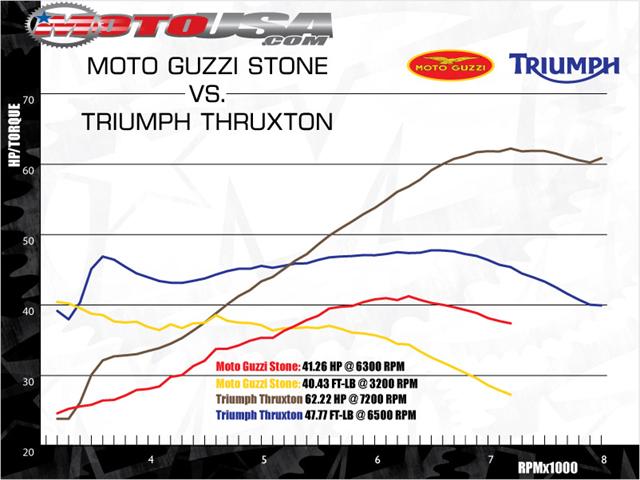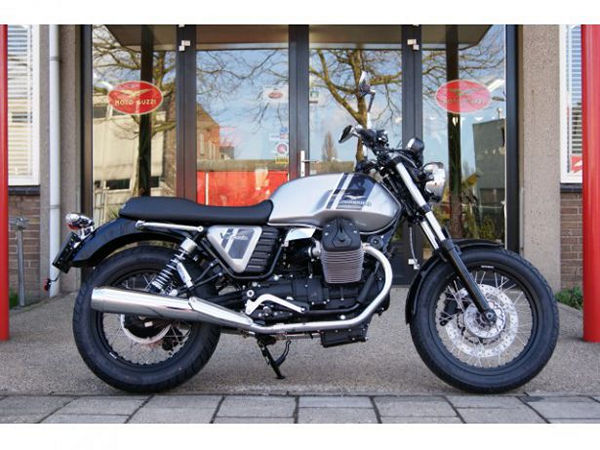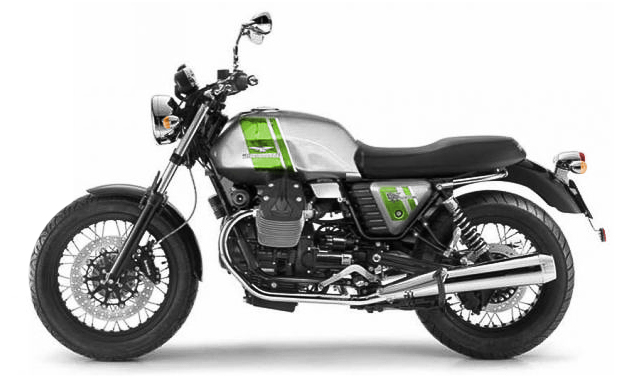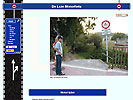A ride report of the Moto Guzzi V7, both in the 2013-Stone version as in the slightly older Cafe-version (with that splendid green color that apparently only Guzzi is able to produce).
The V7 with the new engine is wonderfully agile, reacts alertly and directly, and is a joy to ride. Bonus is that unique feeling of the engine vibrating to the left and right if the clutch is disengaged.
The Cafe-version with the slightly older engine reacts slower, both on the gas as on steering. On the other hand, it gives even more of that "Guzzi feeling", both with respect to the sound and to the vibrations and the behaviour of the engine.
But for me: please give me the new V7!
![]() Er is een Nederlandse versie:
Er is een Nederlandse versie:
https://www.luiemotorfiets.nl/motoren/V7/
The Moto Guzzi V7, new and newer
Old?
If you would call the green V7 on this photograph the "old" version, you would think, because it is a Moto Guzzi, that it would be really old, but the older version of the V7 isn't that old...
In 2012 the engine of the V7 has been revamped, and the bike itself has become much lighter (the wheels in particular), which makes him much more agile. Those changes are so big that you might call the green one the old version of the V7.
We did take both of them for a test ride, to be able to compare them.
There is a really old V7
There is a real old V7, from 1969. That Guzzi is not part of this ride report: we did a test ride on two modern motorbikes, at Teo Lamers in Nijmegen, the Netherlands.
Three versions of the newest V7
There are three different versions of the newest V7. They share the same engine, but have different looks:
Stone
The Stone is in matted black or white. He has cast wheels and a flat saddle. The riding position is straight up.
The Stone is one of the motorcycles of this test ride: you see him on the photographs above.
Special
The Special has spoke wheels, is in black with orange or grey with dark grey, and is, apart from that, the same as the Stone.
The Special is a beautiful classic-like "ordinary" motorbike.
Unfortunately Teo Lamers didn't have one at the time we were there, but we have a photograph below.
Sport
The Sport is the most spectecular of the three. Hij has either a black tank or a shiny aluminium one, has clip-ons, and comes with a red frame (which looks fabulous), and has the footrests more to the back in comparison to the Stone and the Special.
You see him on the photograph here. It is a beautiful, nostalgic looking small racer.
The dashboard
Speedometer and rev counter
The Speedometer and rev counter are "old fashioned" round clocks.
You can read them much faster, in one blink of an eye, than a digital number on a digital display: the position of the indicator is visible from the corners of your eyes, and it doesn't take long before you can read those clocks like you can read clocks for time. You don't need the numbers anymore to know exactly which speed you are riding or which revs you are turning.
At the bottom of the clocks you see the (digital) tripmeter and mileage meter.
Control lights
Between the two clocks are six control lights, in an upside down pyramid.
So the dashboard is simple but effective.
And every time you look at the dashboard, you see the logo of Moto Guzzi. If you are, like me, a Moto Guzzi lover from the moment you ride motorcycles, that is a bonus ;-)
Pentagonal mirrors
The mirrors are not round but have five corners
The view was good (but mirrors that miniy and therfore offer a broader view would have been better).
Classic looks
In this photogrpah, you see again how classic the V7 looks, also from behind.
It's a shame that we have those monstruously big license plates in the Netherlands!
The saddle and the seat height
The saddle of the Stone and the Special
The saddle of the Stone and the Special that you see here, doesn't have a ridge where the part for the pillion rider begins.
This has the great advantage that when you ride solo, are able to shift forward and backward. During long journeys, for example during a holiday, this is ideal: your weight is carried by a different part of your buttocks all the time, so you avoid getting painfull buttocks.
The saddle is very comfortable. It doesn't seem too soft (a soft saddle seems delicious at first, but because it will take the form of a pit in which your bum fits perfectly, you will be sitting in exactly the same way the whole ride long, which will have a painful butt as a result), but of course, you can only know for sure after having ridden the V7 for many hours.
During our test ride (about an hour and a half) it seemed a perfect saddle.
Seat height
I am 169 cm tall, and have relatively short legs. I could easily touch the ground with both feet: the V7 certainly is not hihj.
Starting
Sound
When you start the engine (of course, the V7 starts immediately without any trouble), the first thing you will notice is the sound: beautiful and low, a feast for the ears!
The sound of the Cafe (only for sale as a used bike) is even deeper than the sound of the newer V7's like the Stone, but the newer ones also create a beautiful music.
Vibrations
The second thing you'll notice, when the bike is still in neutral, is the vibrating engine. It vibrates from left to right and back. It feels fantastic: you litterally feel the placing of the cylinders, and you feel them fire one after the other.
I can't imagina anyone who would not be charmed by those vibrations.
Riding off
While riding off, two aspects are immediately clear:
- The Stone and the older Cafe have punch dirtectly in the lower revs: you can let go of the clutch almost immediately. A motorcycle performing so well at low revs is ideal in lots of situations.
- The Stone reacts directly and agile on steering input. It makes him very maneuvrable. That's different with the Cafe: he is slower to react, and the steering is therefore more cumbersome. The reason is that the wheels are heavier, and that he has clipons for the steer.
Weight
Also directly noticeable is the low weight. The Stone weighs only 179 kilo, which is very light for a bike of 750cc with a cardan. That low weight is one of the reasons that he is so well manageable at low speed.
Torque and power

Moto Guzzi V7 and Triumph Thruxton
The torque and power curve of the V7 are here visible together with those of the Triumph Thruxton (which has a displacement of 900cc opposed to the 750cc of the V7).
You see the red line of the V7 getting to its maximum power at rpm.
Torque
The torque curve of the V7 shows that it has much torque directly in the very low revs. That is in accordance with the fact that the V7 is so easy to ride at very low speeds and that you can accelerate very well when the traffic ight goes green.
The maximum torque is, therefore, early: at 2800 rpm. That's where he accelerates fastest.
You are able to let the engine rev much higher, and reach a higher speed than at 2800 rpm. But the V7 is at its most agile, its most delicious, around those 2800 rpm.
That is a delight in the city, or on narrow mountain roads.
Ride in the city
Looking for the Ooijdijk
We had to look for the Ooijdijk, and in our search, we rode through Nijmegen (with lots of works on the roads). The photographer rode in front, so we only have a movie of this part, with a small part of the city and then the Ooijdijk.
Because of our search, I could judge the suitability of the V7 for city traffic.
Agile
The V7 is very agile, which is, of course, a big pro for riding in the city.
Short corners, turning right at the last moment instead of to the left, it's no problem at all with the light, agile V7.
Shifting
Whoever of used to ride a Japanese bike will have to get used to how you shift: your feet have to travel a much longer path to shift up or down.
For me, who did ride a BMW for many years, this is no problem at all. I never did mis-shift.
Riding on the Ooijdijk
Steering
The V7 Stone (and therefore also the Special) is easy to flick into a corner, and reacts directly on your input. It makes him ideal for narrow winding roads like this dyke.
Also noticeable is how much confidens=ce he gives you, and how much fun he is to ride. I am extremely careful and hesitant with a motorcycle I don't know, in particaluar if it is a motorcycle of somebody else, but in this case I felt at home soon.
Reaction on the gas
On this road, it is also clear how deliciously direct the V7 reacts on the gas.
Speed
Of course, we didn't go faster than 80 km/u during this test ride.
But is seems obvious that higher speeds will not be any problem, as long as you don't act like you're riding on a circuit, outperforming the CB1100's.
The V7 offers enough to ride everywhere you would like to ride, even on the German Autobahn.
Sound
At the start of this movie you can hear the sound of the V7 (from the moment the photographer rides himself, you can only hear the wind, unfortunately).
Suspension and brakes
Suspension
Concerning the suspension, we have only experience how the V7 behaves on speed bumps: we didn't corner as racers and we didn't ride any unpaved roads. The V7 doesn't have any trouble with speed bumps.
Our impression is that the suspension is not too hard, which is what you want when you ride on anything else than perfect circuit-tarmac, but like narrow roads with bumps or cobblestones.
As a result, you will not be able to ride extremely gast through corners, as a racer, but it also means that you can ride litterally every road you want.
So, in our opinion, the springs and suspension of the V7 are ideal for a street bike.
Brakes
To be honest, we didn't try to brake really hard.
So the only thing we can write about the brakes is that there is no ABS (plans are that in a couple of years there will be an option for ABS), and that the brakes are in accordance to that absent ABS: they are not aggressive; it will be hard to brake too hard and fall...
For whom?

Beginners and reborn bikers
Of course, the Moto Guzzi V7 is, in the first place, a very good bike for beginners and those who have a pause of many years in their riding career: it is a two-cylinder motorcycle with much torque down low, with a pleasant steering behaviour.
A nice feature is that he feels very "alert", because of the vibrations of the engine and because his agile reaction on the gas and on steering. So he doesn't feel like a beginner's bike.
Allround
But it would be a mistake only to consider the V7 a beginner's bike: everybody who loves the looks of a classic, who loves "character", who loves a motorcycle that doesn't need much maintenance (the V7 has a shaft drive), who wants to ride long distances on one tank (the V7 has 22 liters on board and is economical), finds a very pleasant and beautiful bike in the V7.
He feels at home everywhere, fron=m the inner city to bumby rural roads, and even if necessary on the Autobahn (but be honest, who would like to give his or her motorcycle square tyres by riding the Autobahn?)
The V7 is a surprising, personal allrounder.
The ideal motorcycle for travel

I was looking for the ideal travel bike. The V7 has some characteristiscs that are very attractive for a travel bike:
Shaft drive
The V7 has a shaft drive, and despite that fact it only weighs 179 kilo (with a full tank).
A shaft drive is ideal in every circumstance (for instance for commuting), but in particular for traveling. You don't have to take any chain grease with you, and you don't have to lubricate the chain when you arrive, tired, at the place where you want to spend the night.
Range
Another big advantage is the range that the tank gives you. The tank contains 22 liters, and the V7 appears to be economical.
Moto Guzzi doesn't give any statements, but we did hear the story of somebodt who rode 30 kilometers on one liter (but I guess this was during a long day ride on small roads without traffic lights or strong wind).
The V7 will be my travel bike
So maybe it's nice to mention that the V7 Special is now my official travel bike ;-)
This is not the colour!
The plans for the 2013 V7 Special were that it would get this colour cheme, but Guzzi has changed plans. The real colour scheme is the one on the photograph above.
The V7 Stone, Special and Sport specificaties
The engine
| V7 Stone, Special and Sport | |
|---|---|
| Type | 2cylinder 90° V-twin air cooled 1 carburatter |
| Bore x stroke | 80 x 74 mm |
| Cylinder capacity | 744 cc |
| Power | 35kW (47.6pk) at 5.000 rpm |
| Torque | 60Nm at 2.800 rpm |
| Compression ratio | 9.6 : 1 |
| Mixture control | Weber-Marelli electronic fuel injection |
Power transmission
| V7 Stone, Special and Sport | |
|---|---|
| Clutch | Dry single disc |
| Gearbox | 5-speed gearbox |
| Drivetrain | Shaft |
Chassis, brakes
| V7 Stone, Special and Sport | |
|---|---|
| Frame | Double steel stalen cradle frame detachable subframe at the rear |
| Suspension front | Marzochi telescopic fork, 40 mm |
| Travel front | 130mm |
| Suspension rear | Cast aluminium swingarm with 2 adjustable Bitubo shock absorbers |
| Travel rear | 118mm |
| Wheel base | 1448 mm |
| Casor (trail) | 109 mm |
| Steering head angle | 2750 |
| Wheels | Spokes, aluminium |
| Tyres, front | 100/90- 18 56H TL |
| Tyres, rear | 130/80 -17 65H TL |
| Brakes front | 320mm floating disc, Brembo 4-piston caliper |
| Brakes rear | 260mm, Brembo 2-piston caliper |
Dimensions and weights
| V7 Stone, Special and Sport | |
|---|---|
| Seat height | 805 mm |
| Weight, road ready, fully fuelled | 179 kg |
| Tank capacity | 22 liter |
| Length | 2184 mm |
| Height (without mirrors) | 1112 mm |
| Width (with mirrors) | 800 mm |
Comments, Q & A, on a separate page




